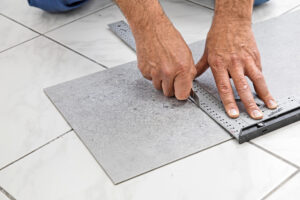- 3 min reading time
Sustainability in construction and renovation: 5 tips for conscious planning
Climate protection, resource conservation and healthy living – sustainable construction and renovation have long been more than just a trend. More and more people want to create living spaces that function in the long term, do not harm the environment and enable healthy living. It is not about being perfect – it is about being better informed.
These five tips will help you make informed decisions on your next project and integrate sustainability step by step.
1. Look for low-pollutant materials
Many building materials contain ingredients that are permissible but not necessarily beneficial to health, such as plasticisers, formaldehyde or chlorinated plastics. Air quality is particularly important indoors, as we spend most of our lives in closed rooms.
What helps?
Certifications such as the Blue Angels or the eco-INSTITUT label provide guidance. Those who consistently choose low-emission or pollutant-free materials ensure a healthier indoor climate – especially in bedrooms and children's rooms.
2. Focus on longevity rather than quick fixes
The longer a product lasts, the smaller its ecological footprint. This applies to furniture, floor coverings, paints and insulation materials. Sustainable products are often not the cheapest ones, but those that do not need to be replaced after just a few years.
Practical tip:
Robust floor coverings or surfaces that are easy to clean and repair are not only environmentally friendly in the long term, but also make good economic sense.
3. Use what you have – instead of starting from scratch
When renovating, people often automatically tear things down, throw them away and replace them. But it's worth taking a second look: can an old floor be covered instead of torn up? Can a piece of furniture be refurbished? Does everything really need to be repainted?
What's the point?
Less waste, lower energy consumption and resource-efficient use of materials. And sometimes, even more character is retained in the room.
Example:
Flooring that can be laid on top of existing tiles not only saves work but also avoids construction waste. Modern design floor coverings with a low installation height – such as mineral-based products – are particularly suitable.
4. Think about cycles: recyclable instead of disposable
An essential part of sustainable construction is the question: What happens to the material at the end of its useful life? Can it be recycled or will it be incinerated? Are there take-back or recycling systems in place?
What to look out for?
Products that are single-origin and free from problematic additives are usually easier to recycle. It is worth taking a look at the product information provided by many manufacturers – the more transparent, the better.
Our CERAMIN floors are fully recyclable and thus remain permanently in the material cycle.
5. Short distances and conscious product selection
Regional products do not automatically mean greater sustainability – but they do reduce transport emissions and make production conditions more transparent. If you know where and how something was produced, you are better able to assess whether it fits in with your own values.
Sample questions:
- Is the product manufactured in Europe or overseas?
- What information is available about the supply chain?
- How does the manufacturer deal with environmental standards?
The building product itself should also fit in with the design: flooring made from recycled materials that can be recycled again at the end of its life is one example of how sustainability can be considered holistically.
A practical example: What makes CERAMIN a sustainable choice
If you are looking for flooring that combines ecological responsibility with modern design, you will find it in CERAMIN A convincing solution. The mineral design coverings are manufactured in Germany, are free of PVC and plasticisers, low in emissions and fully recyclable. Thanks to their dimensional stability, they are suitable for full-surface installation as well as for covering old substrates – such as tiles – thereby avoiding additional construction waste.
With its focus on material health, resource conservation and recyclability, CERAMIN consistently meets the requirements of sustainable interior design.
Conclusion: Small decisions, big impact
Sustainable construction is not an ‘all or nothing’ proposition. Even individual decisions – such as choosing a durable material, avoiding certain harmful substances or covering rather than removing – have positive effects. Those who inform themselves and proceed step by step contribute to reducing environmental pollution while creating sustainable living spaces.



